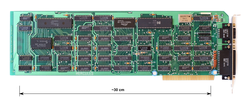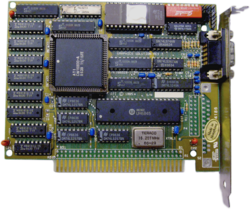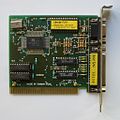Hercules Graphics Card
 From Wikipedia - Reading time: 12 min
From Wikipedia - Reading time: 12 min
 HGC with parallel port | |
| Release date | 1982 |
|---|---|
| Architecture | Motorola 6845 |
| Cards | |
| Entry-level | Hercules Graphics Card |
| Mid-range | Hercules Graphics Card Plus |
| High-end | Hercules InColor Card |
| History | |
| Predecessor | MDA, CGA |
| Successor | Enhanced Graphics Adapter |
The Hercules Graphics Card (HGC) is a computer graphics controller formerly made by Hercules Computer Technology, Inc. that combines IBM's text-only MDA display standard with a bitmapped graphics mode, also offering a parallel printer port.[1][2] This allows the HGC to offer both high-quality text and graphics from a single card.
The HGC was very popular and became a widely supported de facto display standard on IBM PC compatibles. The HGC standard was used long after more technically capable systems had entered the market, especially on dual-monitor setups.
History
[edit]The Hercules Graphics Card was released to fill a gap in the IBM video product lineup. When the IBM Personal Computer was launched in 1981, it had two graphics cards available: the Color Graphics Adapter (CGA) and the Monochrome Display And Printer Adapter (MDA). CGA offered low-resolution (320 × 200) color graphics and medium-resolution (640 × 200) monochrome graphics, while MDA offers a sharper text mode (equivalent to 720 × 350) but has no per-pixel addressing modes and is limited to a fixed character set.
These adapters were quickly found to be inadequate by the market, creating a demand for a card that offers high-resolution graphics and text.[3] The founder of Hercules Computer Technology, Van Suwannukul, created the Hercules Graphics Card so that he could work on his doctoral thesis on an IBM PC using the Thai alphabet, impossible with the low resolution of CGA or the fixed character set of MDA.[4] It initially retailed in 1982 for $499.[5]
Hardware design
[edit]The original HGC is an 8-bit ISA card with 64 KB of RAM, visible on the board as eight 4164 RAM chips, and a DE-9 output compatible with the IBM monochrome monitor used with the MDA. Like the MDA, it includes a parallel interface for attaching a printer.[1]
The video output is 5 V TTL, as with the MDA card.[6][7][8] Nominally, the Hercules card provides a horizontal scanning frequency of 18.425 ± 0.500 kHz and 50 Hz vertical.[9] It runs at two slightly different sets of frequencies depending on whether in text or graphics mode, providing a different vertical refresh rate and a different aspect ratio via a different pixel clock and number of scanlines.[citation needed]
Capabilities
[edit]



The Hercules card provides two modes:
- 80 × 25 text mode with 9 × 14 pixel font (effective resolution of 720 × 350, MDA-compatible)
- 720 × 348 graphics mode (pixel-addressable graphics)[10]
The text mode of the Hercules card uses the same signal timing as the MDA text mode.
The Hercules graphics mode is similar to the CGA high-resolution (640 × 200) two-color mode; the video buffer contains a packed-pixel bitmap (eight pixels per byte, one bit per pixel) with the same byte format—including the pixel-to-bit mapping and byte order—as the CGA two-color graphics mode, and the video buffer is also split into interleaved banks, each 8 KB in size.
However, because in the Hercules graphics mode there are more than 256 scanlines and the display buffer size is nearly 32 KB (instead of 16 KB as in all CGA graphics modes), four interleaved banks are used in the Hercules mode instead of two as in the CGA modes. Also, to represent 720 pixels per line instead of 640 as on the CGA, each scanline has 90 bytes of pixel data instead of 80.[11]
The 64 KB RAM of the HGC can hold two graphics display pages. Either page can be selected for display by setting a single bit in the Mode Control Register. Another bit, in a configuration register exclusive to the HGC, determines whether the second 32 KB of RAM on the HGC is accessible to the CPU at the base address B8000h. This bit is reset at system reset (e.g. power-on) so that the card does not conflict with a CGA or other color card at address B8000h.[12]
Use
[edit]In text mode, the HGC appears exactly like an MDA card.[13] Graphics mode requires new techniques to use. Unlike the MDA and CGA, the PC BIOS provides no intrinsic support for the HGC. Hercules developed extensions, called HBASIC, for IBM Advanced BASIC to add HGC support[14] and Hercules cards came with Graph X, a software library for Hercules graphical-mode support and geometric primitives.[13]
Popular IBM PC programs such as Lotus 1-2-3 spreadsheet,[13] AutoCAD computer-aided drafting, Pagemaker and Xerox Ventura desktop publishing, and Microsoft Flight Simulator 2.0 came with their own drivers to use the Hercules graphics mode.[15]
Though the graphics mode of the Hercules card is not CGA-compatible, it is similar enough to the two CGA graphics modes that with the use of third-party terminate-and-stay-resident programs it can also work with programs written for the CGA card's standard graphics modes. As the Hercules card does not actually have color-generating circuitry, nor can it connect to a color monitor, color appears as simulated grayscale in varying dithering patterns.[16][17][18]
Clones of the Hercules appeared, including generic models at very low prices, usually without the printer port. Hercules advertisements implied that use of generic Hercules clones can damage the monitor.[19]
Reception
[edit]The Hercules Graphics Card was very successful, especially after Lotus 1-2-3 supported it, with one-half million units sold by 1985. As of June 1986[update] Hercules Computer Technology had 18% of the graphics card market, second to IBM.[20] Hercules-compatible graphics cards shipped as standard hardware with most PC clones. As a de facto standard, support in software was widespread.[10]
Card versions
[edit]The Hercules Graphics Card had several versions.
Hercules Graphics Card
[edit]Several updated versions of the original Hercules Graphics Card exist. The original board from 1982 is referenced as GB100, with updated versions in 1983 (GB101), 1984 (GB102) and 1988 (GB102Z).[21]
Hercules Graphics Card Plus
[edit]The Hercules Graphics Card Plus or HGC+ (GB112) was released in June 1986 at an original retail price of $299.[22] It was an enhancement of the HGC, adding support for redefinable fonts called RAMFONT in MDA-compatible text mode.[23] It was based around a specialty chip designed by Hercules Computer Technology, unlike the original Hercules Graphics Card, which used standard components.[24] Software support included Lotus 1-2-3 v2, Symphony 1.1, Framework II and Microsoft Word 3.[22]
Hercules Network Card Plus
[edit]In 1988 Hercules released the Hercules Network Card Plus, (HNC NB112) a variant of the Graphics Card Plus with an integrated TOPS/FlashTalk-compatible network adapter.[25] Like the HGC+, it supported RAMFONT, but lacked a printer port.[26][27][28]
Hercules InColor Card
[edit]The InColor Card (GB222) was introduced in April 1987. It included color capabilities similar to the EGA, with 16 colors from a palette of 64. It retained the same two modes (80 × 25 text with redefinable fonts and 720 × 348 graphics), and was backward-compatible with software written for the earlier monochrome Hercules cards.[29][30][31][32][33]
Hercules Color Card
[edit]The Hercules Color Card (GB200) was a CGA-compatible video board and should not be confused with the InColor Card.[34] This board could coexist with the HGC and still allow both graphics pages to be used.[35] It would detect when the second graphics page was selected and disable access to its own memory, which would otherwise have been at the same addresses. A version without printer port exists[36]
Hercules Text Card
[edit]The Hercules Text Card was a text-only MDA clone, but offered a parallel printer port.[37]
Clone boards
[edit]Other boards offered Hercules compatibility.[38]
- SiS 86C12, 86C22
- ATI Small Wonder Graphics Solution, 18700, Graphics Solution Plus
- Tamarack Microelectronics TD3088A, TD3088A2, TD3088A3, TD3010, RY-3301, TD3010
- Yamaha V6366C-F, V6363-F, V6363
- Winbond W86855AF, W86855AF
- NEC μPD65042GD
- Tseng Labs ET1000-A
- DFI MG-150
- Hitachi HD6445P4, HD6845SP
- RAM MCG2502, MCG2502
- Proton PT6121T
- Acer M3127
- Sigma Designs 53C101+53C280A
- CM607P
- AST Research AST Preview![39]
Certain later models of the Tandy 1000 (such as the 1000 TL and SL) and the Epson Equity[40] contained circuitry built into their CPU boards that supported Hercules display modes in addition to their standard CGA modes.
-
Tseng ET-1000 Hercules compatible card
-
ATI Hercules compatible card from 1986
-
A Tamarack Microelectronics Hercules compatible card
-
Uncle-RAY Hercules compatible card
See also
[edit]- Orchid Graphics Adapter
- Plantronics Colorplus
- IBM Monochrome Display Adapter
- Color Graphics Adapter
- Light pen
- List of display interfaces
- List of defunct graphics chips and card companies
References
[edit]- ^ a b "Hardware News". InfoWorld. 27 September 1982. p. 77.
- ^ "Hardware / Hercules Computer Technology, HTC // retrocmp / retro computing". retrocmp.de. Retrieved 2023-04-13.
- ^ Gibson, Steve (19 Sep 1988). "IBM's EGA unified backward-compatible CGA, MDA, Hercules standards". InfoWorld. p. 49.
- ^ "Monitors for VGA and beyond". PC Magazine. 16 May 1989. p. 96.
- ^ Welch, Mark (1 September 1986). "Hercules improves its monochrome card". InfoWorld. p. 42.
- ^ "IBM PC-Compatible EGA Video Reference". Archived from the original on 2014-05-11. Retrieved 2007-08-22. 070822 nemesis.lonestar.org
- ^ White, Ray (2004). "Monitor Ports - Obsolete Interfaces". Technology Guides. Archived from the original on 2017-03-22.
- ^ "PC video hardware page: Monitor connections". ePanorama.net. 2011. Archived from the original on 2017-03-17. Retrieved 2023-04-13.
- ^ "Industrial monochrome monitors 7"–14"" (PDF). Archived from the original (PDF) on 2007-02-02. 070822 adm-electronic.de
- ^ a b Pointing, Bob (June 26, 1989). "High-Resolution Standard Is Latest Step in DOS Graphics Evolution". InfoWorld. p. 48.
- ^ Hercules Graphics Card Owner's Manual. p. 16.
- ^ Hercules Graphics Card Owner's Manual. p. 3.
- ^ a b c Wadlow, Tom (December 1983). "The Hercules Graphics Card". BYTE. p. 343. Retrieved 2013-10-20.
- ^ Wadlow, Tom (December 1983). "The Hercules Graphics Card" (PDF). BYTE Magazine. p. 343.
- ^ "Microsoft Flight Simulator (v2.0) back cover scan". MobyGames. May 1984.
- ^ "ibm pc - How do CGA emulators for Hercules graphics work?". Retrocomputing Stack Exchange. Retrieved 2021-02-07.
- ^ "CGA Simulators for Hercules Cards". DOS Days - Old PC Computing Resource. Retrieved 2022-12-03.
- ^ Guzis, C. (1987). "SIMCGA - A CGA SIMULATOR FOR MONOCHROME GRAPHICS CARDS". The Programmer's Corner. Archived from the original on 2022-12-03. Retrieved 2022-12-03.
- ^ "Hercules ad from Byte Magazine April 1985". Byte Magazine. April 1985.
- ^ Bright, David (June 23, 1986). "Hercules graphics card to debut". Computerworld. p. 52.
- ^ Brase, Thomas. "Hardware / Hercules Computer Technology, Hercules Graphics Cards (HGC)". retrocmp.de - BRING OLD HARDWARE BACK TO LIFE AGAIN. Retrieved 2023-04-13.
- ^ a b Welch, Mark (September 1, 1986). "Hercules improves its monochrome card". InfoWorld. p. 41.
- ^ Elliott, John C. (2012-08-09). "Hercules Graphics Card Plus: Notes". John Elliott's homepage. Archived from the original on 2016-11-23. Retrieved 2016-11-23.
- ^ "Inside the IBM PC: Before you consider the Hercules Graphics Card Plus consider the technology behind it". Byte Magazine (Advertisement). 11. October 1986. Retrieved 2016-11-24.
- ^ Stephens; Moran (March 21, 1988). "Hercules to ship card after 3-month delay". InfoWorld. p. 21.
- ^ CW (1988-04-22). "Hercules bringt neues PC-Board mit Ramfont: Grafik und Netzwerk auf einer Karte". Computerwoche (in German). Retrieved 2016-11-24.
- ^ "Hercules Network Card Plus". PC Magazine. 1988-05-31. Retrieved 2016-11-24.
- ^ Patton, Carole (October 26, 1987). "Hercules Weds Networking and Video on 1 Board". InfoWorld. p. 20.
- ^ Elliott, John C. (2012-08-05). "Hercules InColor Card: Notes". Archived from the original on 2016-11-23. Retrieved 2016-11-23. (Pictures and programming information)
- ^ Wilton, Richard (1987). Programmer's guide to the PC & PS/2 video systems (1st ed.). Microsoft Press. ISBN 1-55615-103-9. (NB. The second edition does no longer discuss the InColor and MCGA cards at detail level.)
- ^ Brown, Ralf D. (2012-01-21) [2000-07-16]. "Public Files on FTP.CS.CMU.EDU - The x86 Interrupt List aka "Ralf Brown's Interrupt List" (RBIL)". Archived from the original on 2016-06-16. Retrieved 2016-06-16.
- ^ Brase, Thomas. "Hardware / Hercules Computer Technology, Hercules InColor Card (GB222)". retrocmp - retro computing. Retrieved 2023-03-01.
- ^ CBR Staff Writer (March 1987). "PERSONAL GRAPHICS: HERCULES TO BURST INTO 16 COLOURS". Tech Monitor.
- ^ Hercules Color Card GB200 - Owner's Manual (PDF). Hercules.
- ^ Brase, Thomas. "Hardware / Hercules Computer Technology, Hercules Color Card (GB200)". retrocmp.de - BRING OLD HARDWARE BACK TO LIFE AGAIN. Retrieved 2023-03-13.
- ^ Brase, Thomas. "Hardware / Hercules Computer Technology, Hercules Color Card/NP". retrocmp.de. Retrieved 2023-04-13.
- ^ Brase, Thomas. "Hardware / Hercules Computer Technology, Hercules Text Card". retrocmp.de - BRING OLD HARDWARE BACK TO LIFE AGAIN. Retrieved 2023-04-13.
- ^ "VGA Legacy". Archived from the original on 2014-06-29. Retrieved 2014-06-28.
- ^ Byte Magazine September 1985, page 19 (PDF). 1985. p. 19.
- ^ Equity I+ User's Guide and Diagnostics (PDF). Epson. 1986.
Further reading
[edit]- Wilton, Richard (1987) Programmer's Guide To PC and PS/2 Video Systems, Microsoft Press, ISBN 1-55615-103-9
- Hercules Computer Technology (1987) Hercules Compatibility Guide (a leaflet)
- "Hercules graphics" definition Archived 2005-03-25 at the Wayback Machine, Wi-FiPlanet.com
- How to Print Hercules Graphics SCREEN 3 to an Epson Printer Archived 2009-05-10 at the Wayback Machine, Microsoft.com
- Hercules Monochrome Graphics Adapter, Everything2.com
 KSF
KSF


